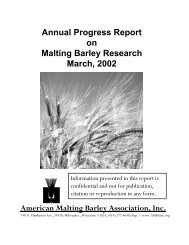Annual Progress Report on Malting Barley Research March, 2007
Annual Progress Report on Malting Barley Research March, 2007
Annual Progress Report on Malting Barley Research March, 2007
You also want an ePaper? Increase the reach of your titles
YUMPU automatically turns print PDFs into web optimized ePapers that Google loves.
germinati<strong>on</strong> that is known to stimulate expressi<strong>on</strong> of many genes in the aleur<strong>on</strong>e layers<br />
surrounding the endosperm.<br />
To analyze expressi<strong>on</strong> of the proteins encoded by the four abundantly expressed<br />
Agl genes, we prepared four antisera. Each antiserum was designed to be specific to<br />
<strong>on</strong>ly <strong>on</strong>e of the four proteins encoded by these four genes. The specificities of these<br />
antisera were determined by testing against extracts of E. coli transformed with <strong>on</strong>e of<br />
each of the four Agl genes we identified. Each of these cultures expressed <strong>on</strong>ly <strong>on</strong>e of<br />
the recombinant isozymes. Each antiserum recognized <strong>on</strong>ly the isozyme c<strong>on</strong>taining<br />
the peptide to which it was designed. Again, in this report we will focus <strong>on</strong> comparing<br />
expressi<strong>on</strong> of the proteins α-glucosidase1 and α-glucosidase2, which are encoded by<br />
Agl1 with Agl2, respectively. Western blot analyses of germinated seed extracts<br />
probed with antibodies that recognized <strong>on</strong>ly the α-glucosidase1 protein showed that this<br />
antibody reacted with seed proteins having molecular masses of approximately 100, 95,<br />
75 and 65 kD. These are data in agreement with those reported by Tibbot et al., 1998.<br />
The anti-α-glucosidse1 probe cross reacted with proteins extracted from seedling<br />
leaves with approximate molecular masses of 100, 95 and 80 kD. The Western blots<br />
using the anti-α-glucosidase2 probe detected cross reacting proteins of approximately<br />
100 and 80 kD in seedling leaves but no cross reacting proteins were detected in<br />
germinated seeds. Possible explanati<strong>on</strong>s of why the Agl2 gene is transcribed yet the<br />
protein is not detected in the seed extracts include: 1) the protein may be present but<br />
below the limits of detecti<strong>on</strong> with the antibody; 2) the seed protein may be processed<br />
differently from the leaf protein such that the epitope is cleaved from the seed protein; 3)<br />
the seed protein may be insoluble possibly via membrane associati<strong>on</strong>s or aggregati<strong>on</strong>s;<br />
or 4) RNA silencing may be occurring in the seeds that is not occurring in the leaves.<br />
Purificati<strong>on</strong> and characterizati<strong>on</strong> of Agl2 dem<strong>on</strong>strated that it not <strong>on</strong>ly had<br />
maltase activity (the definitive test for Agl), but also had α-xylosidase activity.<br />
Xyloglucans were found to be better substrates than maltose for Agl2. This indicates<br />
that although Agl2 can c<strong>on</strong>tribute to starch degradati<strong>on</strong>, it could have a major role in cell<br />
wall degradati<strong>on</strong> during germinati<strong>on</strong>. Xyloglucans are the primary hemicelluloses<br />
120
















